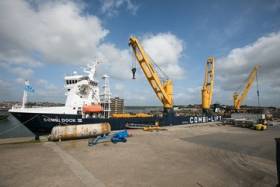Displaying items by tag: Largest Vessel
Largest Cargoship to Berth At Welsh Port Exports Oil Refinery to Pakistan
#ports&shipping - Combi Dock III recently became the largest cargoship to visit Pembroke Port, Wales from where exported parts of a decommissioned oil refinery were loaded and bound for Pakistan.
The Murco refinery in Milford Haven closed in 2014 and is now owned by Puma Energy which runs it as a storage terminal.
Over the past year refinery parts have been transported by road to Pembroke Port for storage on the 69 acre site, with a team experienced in heavy lifts and unusual cargo, where the Combi Dock III was berthed. Additionally, a 201 tonne reactor was transported by the Terra Marique barge from Gelliswick Bay to Pembroke Port as it was too large to be moved by road.
The Combi Dock III is the largest vessel to berth at Pembroke Port, weighing in at 17,341 gross tons, measuring 162m in length with a beam of 25m. 3,239.94 tonnes of cargo is now on route to Pakistan; there it is expected to be reassembled. Two further exports of similar sizes are expected to take place over the next twelve to eighteen months.
Director of Quayside Operations at Pembroke Port, Natalie Britton, said “The movement of the refinery parts was well executed and the transfer onto the Combi Dock III ran smoothly. Our team provided moorings, berthing, quay space and laydown area, as well as safety inductions for the contractors on site. This is a prime example of how Pembroke Port can handle large and unusual size cargoes safely and efficiently.”
Afloat adds that Pembroke Port is predominently used as a ferryport by Irish Ferries Isle of Inishmore (34,000 gross tons) that serves the link to Rosslare.
There has been a ferry service between south Wales and Wexford since 1980 when the Pembrokeshire port was first developed for such operations. This involved the former Irish State owned shipping operator B+I Line running the route.
In more recent times, a berth nearby to the ferry linkspan, has been used to accommodate cruiseships.






























































